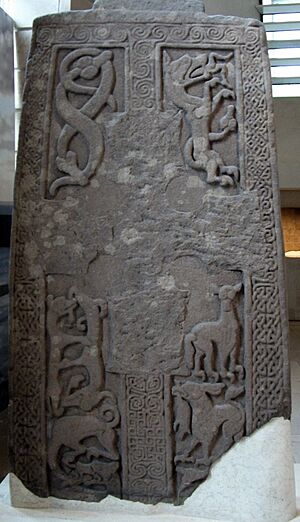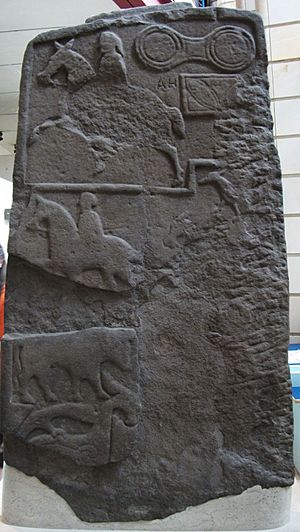Woodwrae Stone facts for kids
Quick facts for kids The Woodwrae Stone |
|
|---|---|

The Woodwrae Stone
|
|
| Material | Old Red Sandstone |
| Height | 1.75 metres (5.7 ft) |
| Symbols |
|
| Discovered | 1819 |
| Place | Woodwrae, Angus, Scotland |
| Present location | Museum of Scotland, Edinburgh |
| Coordinates | 55°56′49″N 3°11′21″W / 55.946991°N 3.189183°W |
| Classification | Class II cross slab |
| Culture | Picto-Scottish |
The Woodwrae Stone is an ancient stone carved by the Picts, a people who lived in Scotland long ago. It was made around the 8th or 9th century, which is over 1,100 years ago! This special stone was found in 1819 near Woodwrae Castle in Angus, Scotland. It was actually being used as a floor tile in the castle's kitchen! After it was found, it became part of a collection owned by the famous writer Sir Walter Scott. Today, you can see the Woodwrae Stone at the Museum of Scotland in Edinburgh.
Contents
Where the Stone Was Found
The Woodwrae Stone was discovered at Woodwrae Castle. This castle was about 1 kilometer (0.6 miles) north of Aberlemno in Angus, Scotland. Today, a farm stands where the castle once was.
The stone was being used as a floor slab in the castle. In 1819, it was moved to the collection of Sir Walter Scott at Abbotsford House. It stayed there for many years. In 1924, it was given to the Society of Antiquaries of Scotland.
What the Stone Looks Like
The Woodwrae Stone is a tall, flat stone called a cross-slab. It is about 1.75 meters (5 feet 9 inches) high. It is 1.02 meters (3 feet 4 inches) wide at the bottom. It gets a bit narrower at the top. The stone is about 12.5 centimeters (5 inches) thick.
The stone has carvings on both sides. These carvings are raised from the surface, which is called "relief." Because it has both a cross and Pictish symbols, it is known as a Class II Pictish stone.
The Front Side: The Cross
The front of the stone once had a large cross carved on it. This cross was shaped like a flower with rounded parts. However, someone deliberately removed or damaged the cross. Even so, the beautiful borders around where the cross used to be are still there. These borders are decorated with amazing patterns. They include designs that look like woven ropes (knotwork), maze-like patterns (keywork), and swirling spirals.
Around the cross, there are carvings of strange, imaginary creatures. One of these creatures looks like a beast with human legs hanging from its mouth. You can see similar creatures on other Pictish stones, like the Dunfallandy Stone. They also appear on old Irish crosses.
The Back Side: Symbols and Animals
The back of the stone has been badly damaged over time. It is divided into three parts. The top part shows a person riding a horse. It also has a special Pictish symbol called a "double disc" and a step symbol.
The bottom two-thirds of the stone show another person on horseback. There are also carvings of different animals, including a bull.
How It Connects to Other Stones
The Woodwrae Stone was found very close to Aberlemno, another place in Angus, Scotland. At Aberlemno, there are other famous Pictish stones, also Class II cross-slabs. People have noticed how similar the Woodwrae Stone is to the Aberlemno stones. Some historians think the Woodwrae Stone might have originally come from Aberlemno.
One historian, Ross Trench-Jellicoe, believes there was an "Aberlemno School" of Pictish sculpture. This means a group of artists from the Iona area might have created stones with similar designs. Stones that might belong to this "school" include:
- Aberlemno 2 (the Kirkyard Stone)
- Aberlemno 3
- Menmuir 1
- Kirriemuir 1
- Monifieth 2
Other experts have added more stones to this list. These include the stones from Eassie, Rossie Priory, Glamis 1, and Glamis 2.


